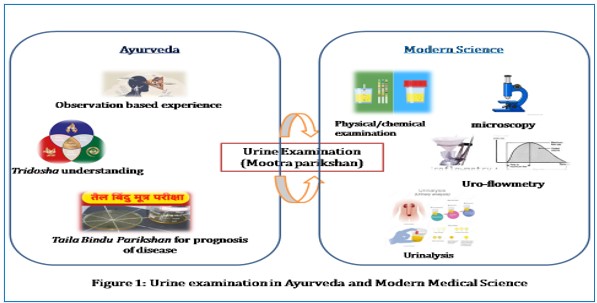Urine Analysis in Ayurveda and Modern Medicine: Exploring Convergence and Divergence
DOI:
https://doi.org/10.21760/jaims.8.10.14Keywords:
Urine examination, Mootra Parikshan, Ayurveda, Tridosha, PrakritiAbstract
Urine examination has played a significant role in medical diagnostics across diverse civilizations throughout history. Ayurveda, a traditional healing system originating in the Indian subcontinent, placed importance on urine analysis as a diagnostic tool. In contrast, modern medical science employs sophisticated laboratory techniques and imaging technologies for urine examination. This manuscript delves into the historical context, techniques, and tools used in Ayurveda for urine examination, comparing them with contemporary scientific approaches. Ayurveda's holistic understanding, rooted in the concept of Tridosha utilized urine examination to identify imbalances and formulate personalized treatments. Ayurvedic physicians observed attributes like color, odor, and sedimentation patterns, aligning them with Doshic qualities. Modern urinalysis encompasses visual, chemical, and microscopic analyses, yielding critical clinical information. Elevated glucose, protein, ketones, presence of blood cells, and crystals provide insights into diabetes, kidney dysfunction, infections, and metabolic disorders. Advanced imaging techniques contribute to urinary tract evaluation. By juxtaposing Ayurvedic and modern approaches, potential correlations and synergies emerge, bridging ancient wisdom with contemporary evidence-based medicine. Integrating personalized Ayurvedic principles with objective modern methodologies could lead to enhanced diagnostic accuracy and patient care. Challenges in integration and the importance of holistic patient-centered care are acknowledged. The exploration of urine examination unites tradition and innovation, fostering interdisciplinary collaboration for a holistic approach to healthcare.
Downloads
References
Echeverry G, Hortin GL, Rai AJ. Introduction to urinalysis: historical perspectives and clinical application. In: The urinary proteome: methods and protocols; 2010. p. 1-2.
Jaiswal YS, Williams LL. A glimpse of Ayurveda - The forgotten history and principles of Indian traditional medicine. J Tradit Complement Med. 2017 Jan 1;7(1):50-3.
Rhoda D. Ayurvedic psychology: Ancient wisdom meets modern science. Int J Transpers Stud. 2014;33(1):14.
Chopra A, Doiphode VV. Ayurvedic medicine: core concept, therapeutic principles, and current relevance. Med Clin. 2002 Jan 1;86(1):75-89.
Jain S. Ayurveda: the ancient Indian system of medicine. In: Complementary and alternative therapies for epilepsy. New York: Demos Medical Publishing; 2005. p. 123-8.
Vaidya Laxmipati Shatri. Yogratnakara (vidyotini Hindi commentary). Varanasi: Chaukhambha Prakashan; 2015. p. 5.
Tripathy Indradeva, Tripathy Dhayashankar. Vaidhyaprabha hindi commentary on Yogaratnakara, Mutra pareeksha: Verse-1-6. Varanasi: Krishna das academy; 1998. p. 9.
Vaidya HP. Commentaries Sarvangasundari of Arunadatta and Ayurveda Rasayana of Hemadri on Astanga Hrudaya of Vagbhata, Nidana Sthana; Prameha nidana: Chapter 10, Verse -8-16. Varanasi: Chaukhambha orientalia; 2002. p. 503.
Acharya YT. Charaka samhita of Agnivesha, Chikitsa Sthana; Pandu roga chikitsa: chapter 16, Verse 20,34,37. Varanasi: Chaukhambha prakashan; 2013. p. 527-28.
Tripathy Indradeva, Tripathy Dhayashankar. Vaidhyaprabha hindi commentary on Yogaratnakara, Mutra pareeksha: Verse-9-10. Varanasi: Krishna Das academy; 1998. p. 10.
Vaidya HP. Commentaries Sarvangasundari of Arunadatta and Ayurveda Rasayana of Hemadri on Astanga Hrudaya of Vagbhata, Nidana Sthana; Prameha nidana: Chapter 10, Verse -8-16. Varanasi: Chaukhambha orientalia; 2002. p. 503.
Saxena Nirmala. Vangasena samhita of Vangasena, Vol.2; Aristadhikara: chapter 98, Verse-115. Varanasi: Chowkambha Samskrit series; 2004. p. 1269.
Vaidya Laxmipati Shatri. Yogratnakara (vidyotini Hindi commentary), Chapter Mutra Pariksha/9. Varanasi: Chaukhambha Prakashan; 2015. p. 10.
Vaidya Laxmipati Shatri. Yogratnakara (vidyotini Hindi commentary), Chapter Mutra Pariksha/9. Varanasi: Chaukhambha Prakashan; 2015. p. 11.
Acharya Vidyadhar Shukla, Prof. Ravi Dutta Tripathi. Carak Samhita (Hindi translation) Vol. 1. Delhi: Chaukhambha Sanskrit Pratishthan; 2010. p. 511.
Free AH, Free HM. Urinalysis, critical discipline of clinical science. CRC Crit Rev Clin Lab Sci. 1972 Jan 1;3(4):481-531.
Wegner M, Neddermann D, Piorunska-Stolzmann M, Jagodzinski PP. Role of epigenetic mechanisms in the development of chronic complications of diabetes. Diabetes Res Clin Pract. 2014 Aug 1;105(2):164-75.
Snyder S, Pendergraph BE. Detection and evaluation of chronic kidney disease. Am Fam Physician. 2005 Nov 1;72(9):1723-32.
Grauer GF. Early detection of renal damage and disease in dogs and cats. Vet Clin Small Anim Pract. 2005 May 1;35(3):581-96.
Tryggvason K, Pettersson E. Causes and consequences of proteinuria: the kidney filtration barrier and progressive renal failure. J Intern Med. 2003 Sep;254(3):216-24.
Joseph F, Anderson L, Goenka N, Vora J. Starvation-induced true diabetic euglycemic ketoacidosis in severe depression. J Gen Intern Med. 2009 Jan;24:129-31.
Modi A, Agrawal A, Morgan F. Euglycemic diabetic ketoacidosis: a review. Curr Diabetes Rev. 2017 Jun 1;13(3):315-21.
Franz M, Hörl WH. Common errors in diagnosis and management of urinary tract infection. I: Pathophysiology and diagnostic techniques. Nephrol Dial Transplant. 1999 Nov 1;14(11):2746-53.
Yu Y, Sikorski P, Bowman-Gholston C, Cacciabeve N, Nelson KE, Pieper R. Diagnosing inflammation and infection in the urinary system via proteomics. J Transl Med. 2015 Dec;13(1):1-4.
Rosen DA, Hooton TM, Stamm WE, Humphrey PA, Hultgren SJ. Detection of intracellular bacterial communities in human urinary tract infection. PLoS Med. 2007 Dec;4(12):e329.
Hiorns MP. Imaging of the urinary tract: the role of CT and MRI. Pediatr Nephrol. 2011 Jan;26(1):59-68.
Kalb B, Sharma P, Salman K, Ogan K, Pattaras JG, Martin DR. Acute abdominal pain: is there a potential role for MRI in the setting of the emergency department in a patient with renal calculi?. J Magn Reson Imaging. 2010 Nov;32(5):1012-23.
Browne RF, Zwirewich C, Torreggiani WC. Imaging of urinary tract infection in the adult. Eur Radiol Suppl. 2004 Mar;14(3):E168-83.
Winters JC, Dmochowski RR, Goldman HB, Herndon CA, Kobashi KC, Kraus SR, Lemack GE, Nitti VW, Rovner ES, Wein AJ. Urodynamic studies in adults: AUA/SUFU guideline. J Urol. 2012 Dec 1;188(6):2464-72.
Clement KD, Burden H, Warren K, Lapitan MC, Omar MI, Drake MJ. Invasive urodynamic studies for the management of lower urinary tract symptoms (LUTS) in men with voiding dysfunction. Cochrane Database Syst Rev. 2015(4).
Nitti VW. Pressure flow urodynamic studies: the gold standard for diagnosing bladder outlet obstruction. Rev Urol. 2005;7(Suppl 6):S14.















